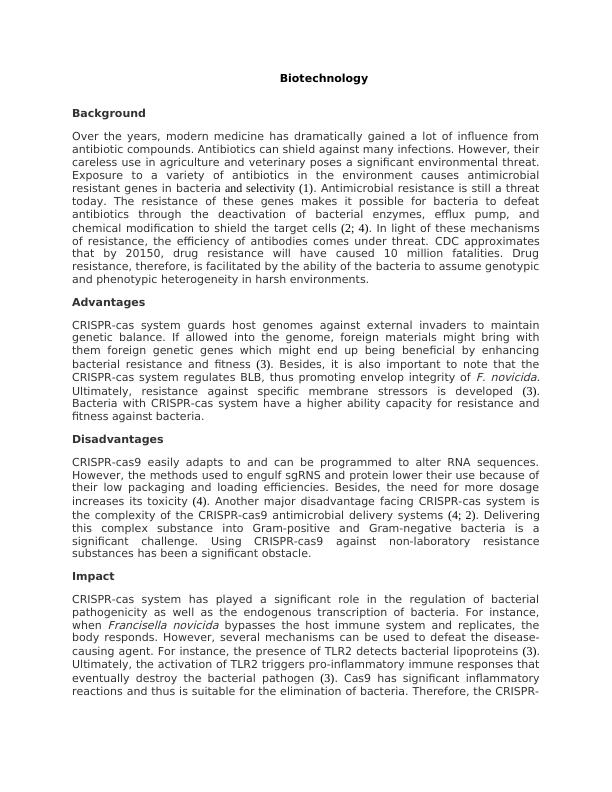Biotechnology Assignment 2022
Added on 2022-09-17
3 Pages689 Words21 Views
Biotechnology
Background
Over the years, modern medicine has dramatically gained a lot of influence from
antibiotic compounds. Antibiotics can shield against many infections. However, their
careless use in agriculture and veterinary poses a significant environmental threat.
Exposure to a variety of antibiotics in the environment causes antimicrobial
resistant genes in bacteria and selectivity (1). Antimicrobial resistance is still a threat
today. The resistance of these genes makes it possible for bacteria to defeat
antibiotics through the deactivation of bacterial enzymes, efflux pump, and
chemical modification to shield the target cells (2; 4). In light of these mechanisms
of resistance, the efficiency of antibodies comes under threat. CDC approximates
that by 20150, drug resistance will have caused 10 million fatalities. Drug
resistance, therefore, is facilitated by the ability of the bacteria to assume genotypic
and phenotypic heterogeneity in harsh environments.
Advantages
CRISPR-cas system guards host genomes against external invaders to maintain
genetic balance. If allowed into the genome, foreign materials might bring with
them foreign genetic genes which might end up being beneficial by enhancing
bacterial resistance and fitness (3). Besides, it is also important to note that the
CRISPR-cas system regulates BLB, thus promoting envelop integrity of
F. novicida.
Ultimately, resistance against specific membrane stressors is developed (3).
Bacteria with CRISPR-cas system have a higher ability capacity for resistance and
fitness against bacteria.
Disadvantages
CRISPR-cas9 easily adapts to and can be programmed to alter RNA sequences.
However, the methods used to engulf sgRNS and protein lower their use because of
their low packaging and loading efficiencies. Besides, the need for more dosage
increases its toxicity (4). Another major disadvantage facing CRISPR-cas system is
the complexity of the CRISPR-cas9 antimicrobial delivery systems (4; 2). Delivering
this complex substance into Gram-positive and Gram-negative bacteria is a
significant challenge. Using CRISPR-cas9 against non-laboratory resistance
substances has been a significant obstacle.
Impact
CRISPR-cas system has played a significant role in the regulation of bacterial
pathogenicity as well as the endogenous transcription of bacteria. For instance,
when
Francisella novicida bypasses the host immune system and replicates, the
body responds. However, several mechanisms can be used to defeat the disease-
causing agent. For instance, the presence of TLR2 detects bacterial lipoproteins (3).
Ultimately, the activation of TLR2 triggers pro-inflammatory immune responses that
eventually destroy the bacterial pathogen (3). Cas9 has significant inflammatory
reactions and thus is suitable for the elimination of bacteria. Therefore, the CRISPR-
Background
Over the years, modern medicine has dramatically gained a lot of influence from
antibiotic compounds. Antibiotics can shield against many infections. However, their
careless use in agriculture and veterinary poses a significant environmental threat.
Exposure to a variety of antibiotics in the environment causes antimicrobial
resistant genes in bacteria and selectivity (1). Antimicrobial resistance is still a threat
today. The resistance of these genes makes it possible for bacteria to defeat
antibiotics through the deactivation of bacterial enzymes, efflux pump, and
chemical modification to shield the target cells (2; 4). In light of these mechanisms
of resistance, the efficiency of antibodies comes under threat. CDC approximates
that by 20150, drug resistance will have caused 10 million fatalities. Drug
resistance, therefore, is facilitated by the ability of the bacteria to assume genotypic
and phenotypic heterogeneity in harsh environments.
Advantages
CRISPR-cas system guards host genomes against external invaders to maintain
genetic balance. If allowed into the genome, foreign materials might bring with
them foreign genetic genes which might end up being beneficial by enhancing
bacterial resistance and fitness (3). Besides, it is also important to note that the
CRISPR-cas system regulates BLB, thus promoting envelop integrity of
F. novicida.
Ultimately, resistance against specific membrane stressors is developed (3).
Bacteria with CRISPR-cas system have a higher ability capacity for resistance and
fitness against bacteria.
Disadvantages
CRISPR-cas9 easily adapts to and can be programmed to alter RNA sequences.
However, the methods used to engulf sgRNS and protein lower their use because of
their low packaging and loading efficiencies. Besides, the need for more dosage
increases its toxicity (4). Another major disadvantage facing CRISPR-cas system is
the complexity of the CRISPR-cas9 antimicrobial delivery systems (4; 2). Delivering
this complex substance into Gram-positive and Gram-negative bacteria is a
significant challenge. Using CRISPR-cas9 against non-laboratory resistance
substances has been a significant obstacle.
Impact
CRISPR-cas system has played a significant role in the regulation of bacterial
pathogenicity as well as the endogenous transcription of bacteria. For instance,
when
Francisella novicida bypasses the host immune system and replicates, the
body responds. However, several mechanisms can be used to defeat the disease-
causing agent. For instance, the presence of TLR2 detects bacterial lipoproteins (3).
Ultimately, the activation of TLR2 triggers pro-inflammatory immune responses that
eventually destroy the bacterial pathogen (3). Cas9 has significant inflammatory
reactions and thus is suitable for the elimination of bacteria. Therefore, the CRISPR-

End of preview
Want to access all the pages? Upload your documents or become a member.
Related Documents
Antibacterial Resistance in Gram Negative Bacteria: Threat to Global Healthlg...
|6
|2112
|202
Natural Selection and Immunological Differences in Specieslg...
|8
|2304
|43